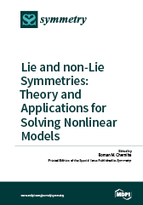Lie Theory and Its Applications
A special issue of Symmetry (ISSN 2073-8994).
Deadline for manuscript submissions: closed (30 June 2015) | Viewed by 70356
Special Issue Editor
2. School of Mathematical Sciences, University of Nottingham, University Park, Nottingham NG7 2RD, UK
Interests: non-linear pdes: lie and conditional symmetries, exact solutions and their properties; application of symmetry-based methods for analytical solving nonlinear initial and boundary value problems arising in mathematical physics and mathematical biology
Special Issues, Collections and Topics in MDPI journals
Special Issue Information
Dear Colleagues,
Since the end of 19th century when the prominent Norwegian mathematician Sophus Lie created the theory of Lie algebras and Lie groups and developed the method of their applications for solving differential equations, his theory and method have continuously been in focus of research of many well-known mathematicians and physicists. This Special Issue of the journal Symmetry is devoted to recent development of Lie theory and its applications for solving physically and biologically motivated equations and models. In particular, the issue welcomes articles devoted to analysis and classification of Lie algebras, which are invariance algebras of real word models; Lie and conditional symmetry classification problems of nonlinear PDEs; the application of symmetry based methods for finding new exact solutions of nonlinear PDEs (especially reaction-diffusion equations) arising in applications; the application of Lie method for solving nonlinear initial and boundary-value problems (especially those for modelling processes with diffusion, heat transfer, and chemotaxis).
Prof. Dr. Roman M. Cherniha
Guest Editor
Manuscript Submission Information
Manuscripts should be submitted online at www.mdpi.com by registering and logging in to this website. Once you are registered, click here to go to the submission form. Manuscripts can be submitted until the deadline. All submissions that pass pre-check are peer-reviewed. Accepted papers will be published continuously in the journal (as soon as accepted) and will be listed together on the special issue website. Research articles, review articles as well as short communications are invited. For planned papers, a title and short abstract (about 100 words) can be sent to the Editorial Office for announcement on this website.
Submitted manuscripts should not have been published previously, nor be under consideration for publication elsewhere (except conference proceedings papers). All manuscripts are thoroughly refereed through a single-blind peer-review process. A guide for authors and other relevant information for submission of manuscripts is available on the Instructions for Authors page. Symmetry is an international peer-reviewed open access monthly journal published by MDPI.
Please visit the Instructions for Authors page before submitting a manuscript. The Article Processing Charge (APC) for publication in this open access journal is 2400 CHF (Swiss Francs). Submitted papers should be well formatted and use good English. Authors may use MDPI's English editing service prior to publication or during author revisions.
Keywords
- Lie algebra/group
- representation of Lie algebra
- Lie symmetry
- conditional symmetry
- invariance algebra of PDE
- nonlinear boundary-value problem
- symmetry of boundary-value problem
- invariant solution
- non-Lie solution
Benefits of Publishing in a Special Issue
- Ease of navigation: Grouping papers by topic helps scholars navigate broad scope journals more efficiently.
- Greater discoverability: Special Issues support the reach and impact of scientific research. Articles in Special Issues are more discoverable and cited more frequently.
- Expansion of research network: Special Issues facilitate connections among authors, fostering scientific collaborations.
- External promotion: Articles in Special Issues are often promoted through the journal's social media, increasing their visibility.
- e-Book format: Special Issues with more than 10 articles can be published as dedicated e-books, ensuring wide and rapid dissemination.
Further information on MDPI's Special Issue polices can be found here.






